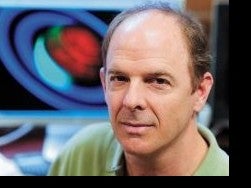Joshua E. Colwell, an associate professor of planetary science at the University of Central Florida, is about to help change that.
In the past three months, Mr. Colwell and a few other university scientists have begun working with a group of small companies that are close to launching a new generation of privately built spacecraft that would let human passengers routinely travel beyond Earth’s atmosphere to the beginning of outer space.
The companies bear such names as Space Adventures, SpaceX, Virgin Galactic, and Orbital Outfitters. They expect their flights, at about $200,000 a ticket, to cater mostly to wealthy tourists, at least at first.
“This isn’t pie in the sky,” Mr. Colwell, who is 45, says with the enthusiasm of one who grew up near the space center in Florida just as NASA was firing off its moon missions. “It actually exists.”
Or, at least, it’s close to existing. Five years ago, the privately financed SpaceShipOne claimed the $10-million Ansari X Prize by completing two manned flights into low Earth orbit. Hopes were high that companies might soon build a series of such spacecraft.
But they met technical and financial hurdles. Three workers died in a July 2007 explosion while testing propellants for SpaceShipTwo, a successor vehicle backed by Virgin Galactic. NASA hasn’t yet made clear whether or how it plans to use private-sector launch capabilities. And the global recession has made raising money difficult.
That’s where Mr. Colwell comes in. In August he was one of 10 experts, mostly from research universities, chosen by the companies to advise them on ways their space vehicles-the first of which are expected to be launched within two years-could be used for research and educational purposes.
The panel of experts represents various academic disciplines, including space life sciences, atmospheric sciences, and aerospace engineering.
Mr. Colwell’s specialty is microgravity physics, with an emphasis on the forces present at the early stages of planetary formation. Many of his colleagues in the field are using low-gravitational-force environments to improve the design and production of vaccines, pharmaceuticals, and materials ranging from tiny electronics to jet-engine turbines.
For such researchers, riding on a new space rocket in low Earth orbit could mean a lot, both professionally and personally. Right now, when Mr. Colwell wants to test how particles behave with little or no gravitational force, his options aren’t good.
One choice is to prepare a boxed experiment to take aboard the space shuttle or space station. But those opportunities are rare and expensive, and he can’t come along to oversee the study.
Another is to fly on a specially equipped research aircraft, such as NASA’s Houston-based C-9B jet, which flies up and down in a series of sweeping parabolic paths to give its passengers a simulated weightless environment on each downward plummet.
But the C-9B’s gravity-free plunges last only about 25 seconds at a time. Worse, it is known as the “vomit comet.” Mr. Colwell has spent a lot of time on the C-9B, and says “it lived up to its nickname as far as I was concerned.”.
On the planned private spacecraft, however, researchers can expect as much as five uninterrupted minutes of low gravitational force as the vehicles briefly reach the edge of Earth’s atmosphere before heading back.
And the researchers and their sponsors may not need to buy a full-price ticket, if they only need a small compartment for their experiment to travel as cargo, Mr. Colwell said. Some projects needing only minor or unskilled human interaction might make use of a cooperative passenger, he said.
Accommodating such educational and scientific needs is now a key element “of any private company’s business plan,” said John W. Gedmark, executive director of the Commercial Spaceflight Federation, the fledgling industry’s lobby group.
Mr. Colwell and his fellow members of the advisory committee, formed by the spaceflight federation, “are now in discussions with universities, government agencies, and other institutions to use these new capabilities in a big way,” Mr. Gedmark said.
It’s a fun sales job for Mr. Colwell, a fan of Star Trek and science-fiction books, who traces his interest in space to the time his mom went to see an Apollo launch while pregnant with him.
The expected availability of such flights has “come up very quickly, and a lot of people don’t know about it,” Mr. Colwell said. “What we’re saying is, ‘Hey, here’s a great opportunity for doing a new form of science.'”
Source: The Chronicle of Higher Education, by Paul Basken, November, 15, 2009.
